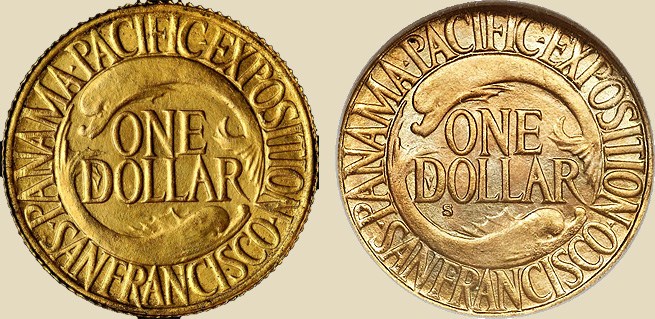NGC to Exhibit Panama-Pacific Exposition Pattern Dollars at FUN 2014
Posted on 12/12/2013
The redesign of United States coins during the years 1905 through 1921 is hailed as the "renaissance" of American coinage. New issues from this era had greater meaning and artistic merit than the coins that came before. To today's scholars, this resulted from unprecedented collaboration between US Mint engravers and leading sculptors of the day.
Unfortunately, only a very small number of pattern coins of this period are available to collectors. Central among them are the pattern coins struck for the Panama-Pacific Exposition.
The Exposition held to celebrate the completion of the Panama Canal was a showcase of its host city, San Francisco. As a means of fundraising, commemorative coins were sold to collectors. This was only the fourth US commemorative coinage program and it was novel in many ways. It consisted of gold and silver issues, including a half dollar, a gold dollar, a gold quarter eagle and half unions($50) of different shapes.
As the commemorative coinage program took form, a proposal was submitted for the coins to be struck on-site during the Exposition. A legal review quickly revealed that coins needed to be struck at a Mint. The San Francisco Mint was, of course, the obvious choice, and all of the Panama-Pacific commemorative coins bear the S mintmark. Pattern coins that resemble the issued coinage were struck without an S mintmark. Farran Zerbe, a prominent numismatist responsible for the distribution of the commemorative coins, recorded that all of the pattern coins without S mintmark were struck at the Philadelphia Mint under the direction of the Secretary of the Treasury William G. McAdoo, himself a coin collector.

Pattern Gold Dollar
This coin’s design celebrates the completion of the Panama Canal in a very direct way. Its obverse shows the head of a man with an unadorned cap representing a laborer, one of the many who built the Panama Canal. On the reverse, two dolphins symbolize the joining of the Atlantic and Pacific oceans.
The coin was designed by Charles Keck, a prominent sculptor who had served as assistant to Augustus Saint-Gaudens throughout the 1890s. His skill is evident here. Despite the comparatively small size of his "canvas," the designs are evocative and memorable.
According to the Judd reference, United States Pattern Coins, a total of 11 Pan-Pac gold dollars were stuck without the S mintmark, nine in gold and two in silver. Three die breaks are evident on all but the first two examples struck. The progression of these cracks has allowed researchers to recreate precisely the emission sequence of the coins. To do this, the coins needed to be examined together, which they were when they resided in the collection of King Farouk of Egypt. At one time he owned each of the examples below.
These coins were re-cataloged in the eighth edition of the Judd reference, but many researchers refer to these coins by their former catalog numbers from the seventh edition which itemized the individual specimens. NGC has included both numbers on its certification labels.
View the Panama-Pacific Exposition Pattern Dollars Exhibit
Stop by the NGC booth (table 1400) at FUN to view this must-see exhibit.
Stay Informed
Want news like this delivered to your inbox once a month? Subscribe to the free NGC eNewsletter today!
